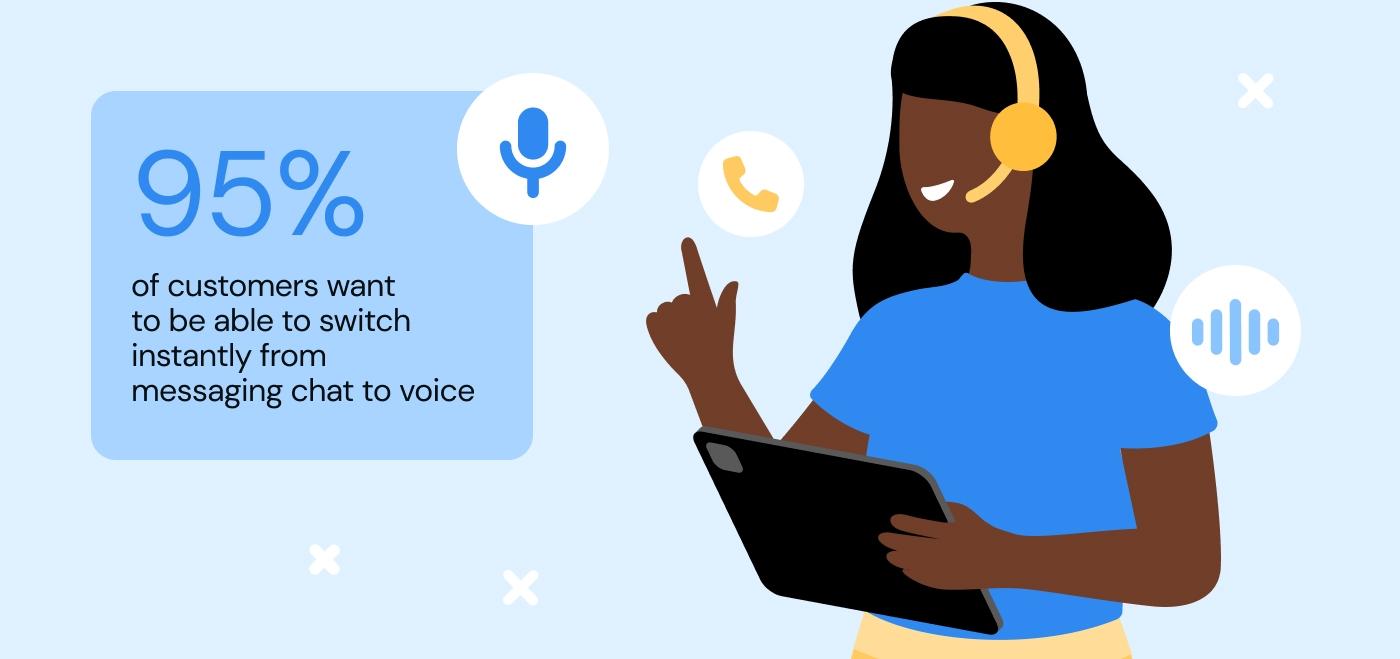Insights
Watch party: The evolution of voice and video

Insights

Imagine a world where every conversation, every meeting, and every shared moment is not just about transferring information, but about creating a connection that feels as personal as a handshake or a warm smile. In this digital era, where the lines between the physical and virtual worlds blur, the power of voice and video communication stands as a testament to human ingenuity, bringing us closer than ever before.
Thanks to Communications Platform as a Service (CPaaS), integrating these capabilities into applications has become seamless, enabling businesses to connect with their customers on a more personal level than ever before.
Let’s take a look at the evolution of voice and video, the use cases they support and how they’re optimized using CPaaS tools.
The journey from traditional telephony to programmable voice and video has been quite the leap in communication technology, moving from hardware-dependent systems to cloud software-driven solutions. In the old days, businesses needed physical phone lines and switchboards, limiting flexibility and scalability. This era was defined by one-size-fits-all, cookie-cutter solutions that offered little in the way of customization or integration with other business processes.
As the internet began to reshape the landscape of global communication, Voice over Internet Protocol (VoIP) emerged, offering a small look into the future by transmitting voice as data over the internet. This was the first major step away from traditional telephony, reducing costs and introducing some level of flexibility and scalability.
The real transformation began with CPaaS, which provided developers with APIs to embed voice, video, and messaging directly into applications and services. This programmability allowed for more customized communication solutions tailored to specific business needs, integrating easily with other digital processes and systems. Businesses could now accelerate innovation and create smooth, personalized customer experiences that were unimaginable with traditional telephony. More than a technological shift, the transition to programmable voice and video is a complete reimagining of how businesses connect with their customers.
Real-time communications, or RTC, is all about making it easy to exchange information immediately, whether that’s text, voice, or video, across different telecommunication services. Essentially, it lets information flow almost instantly from the sender to the receiver, with hardly any wait time or latency. This happens by turning your chats, calls, and videos into digital packets that are transmitted across the internet to their destination. A key part of RTC is making sure that this data is always available for you, giving you access to the tools and tech you need to keep the conversation going smoothly.
Enhancements in network technologies, protocols, and infrastructure have really reduced latency, improved reliability, and boosted the overall quality of communications. Overall, RTC will continue to evolve to provide experiences that emphasize security, low latency, and personalization.

The rapid evolution of voice and video technology is transforming the competitive landscape for businesses across industries. Advancements in these and other areas are reshaping customer expectations, opening new channels for engagement, and offering new opportunities for personalization and efficiency. Let’s delve into some of these trends and how they can help businesses get a competitive edge.
The leap to high-definition video calls has transformed virtual meetings from grainy, lag-prone sessions to crystal-clear, face-to-face conversations — a crucial improvement for businesses with remote work and digital customer interactions becoming the norm.
How businesses use it: In real estate, HD video calls enable virtual property tours that allow potential buyers to explore properties from anywhere in the world. This not only expands the market reach but also enhances the buying experience, setting the company apart from competitors.
Clear communication can make or break a customer service experience. Advancements in voice codecs and noise cancellation technologies make voice calls clearer and more reliable than ever before.
How businesses use it: These technologies ensure support calls are clear and customers feel heard and understood, improving satisfaction and brand loyalty.
The integration of AI-driven real-time translation and transcription into voice and video calls opens up global markets like never before. Businesses can communicate seamlessly with customers or colleagues around the world, regardless of language barriers.
How businesses use it: A company with a global customer base can use real-time translation to offer support in multiple languages without the need for a multilingual staff. This not only improves customer support but also widens the company’s potential market.
AI has taken voice and video communication to the next level. Features like speech recognition, real-time translation, and automated transcription are opening new avenues for improved accessibility, inclusivity, personalization, efficiency, and scalability.
Sentiment analysis powered by AI can gauge the mood and feelings of a customer during a call. This information can be used to tailor responses, guide service strategies, and even route calls to the most suitable agent based on the emotional tone of the conversation.
How businesses use it: A financial services firm uses sentiment analysis to detect frustration or confusion during calls, allowing representatives to adjust their strategy or escalate to specialist advisers to better address customer concerns and ensure a positive experience.
Modern IVR systems use natural language processing (NLP) to understand and respond to customer inquiries more naturally and efficiently, reducing wait times, improving response accuracy, and streamlining the customer experience.
How businesses use it: For an e-commerce platform, an advanced IVR system can drastically improve the efficiency of its customer hotline, enabling customers to check order statuses, initiate returns, or get answers to common questions without speaking to a human agent. The result is a better customer experience, but also improved operational efficiency as it frees human agents to handle more complex queries.
Video analytics technology can analyze video calls to gather insights into customer interactions, identify trends, and even provide real-time feedback to agents.
How businesses use it: A retail company uses video analytics from customer service video calls to analyze facial expressions and engagement levels. This data helps train customer service representatives, improve the customer engagement strategy, and personalize customer interactions based on the visual cues identified during calls.
The evolution in voice and video communication can give businesses a serious edge in today’s competitive, rapidly changing digital landscape, all while making these engagements more human. By adopting these technologies, companies can improve customer satisfaction, open new markets, streamline operations, and ultimately drive long-term growth and success.
Let’s explore some real-life voice features and benefits that CPaaS solutions support.
Ensuring calls are made through a tier-1 network guarantees superior call quality and reliability. Businesses benefit from reduced dropped calls and clearer communications, directly contributing to improved customer satisfaction and trust.
In-app voice calling allows for seamless, real-time conversations globally. This enhances user engagement, keeps communication within the app ecosystem, and can increase the time users spend on the app. It also helps to seamlessly switch from messaging to voice. In fact, according to research we conducted, 95% of customers want to be able to switch instantly from messaging chat to voice.

Intelligent routing ensures calls are directed to the appropriate agent or department efficiently, reducing wait times and improving customer experience. This also optimizes the workload distribution among customer service agents.
Anonymizing voice calls protects both the business and its customers, enhancing privacy and security. This is particularly beneficial for service platforms that connect users with service providers, like ride-sharing or online marketplaces.
By offering high-quality voice services for local, long-distance, or toll-free calls, businesses can expand their reach without breaking the bank. This also ensures that businesses can maintain communication with customers across various regions reliably.
Now let’s check out some video features and how they’re boosting engagement across industries.
Did you know that 94% of customers rate video support as a positive experience? Direct video calls enable personal, high-quality interactions that can strengthen relationships and trust. This is especially important in sectors like finance, healthcare, and consulting where personal rapport is key.

Supporting multiple participants in a single call facilitates teamwork and collaboration, essential for remote or distributed teams. This can improve productivity and accelerate decision-making.
By customizing the video call experience within apps, businesses can offer unique features tailored to their audience, enhancing user engagement, and providing opportunities for innovative service offerings.
The ability to record calls or stream video content allows for a wide range of applications, from creating on-demand content for training and education to broadcasting live events. This can expand a business’s reach and provide valuable resources for customers and employees alike.
Video calls enable remote healthcare services, making medical consultation more accessible and reducing the need for physical visits. This is particularly handy for patients in remote areas or those seeking quick advice without the hassle of visiting a healthcare facility.
As technology marches forward, the potential for transforming communication and customer experience with voice and video communications grows every day.
Ready to start creating experiences that are not just heard or seen but felt? Contact us to learn how we can help you enhance customer interactions with voice and video solutions from Sinch.